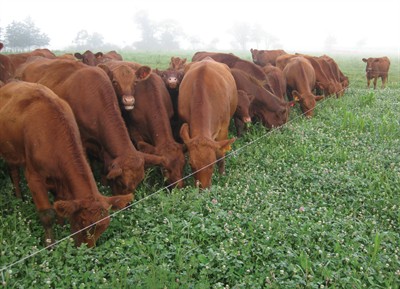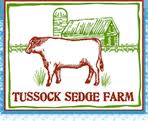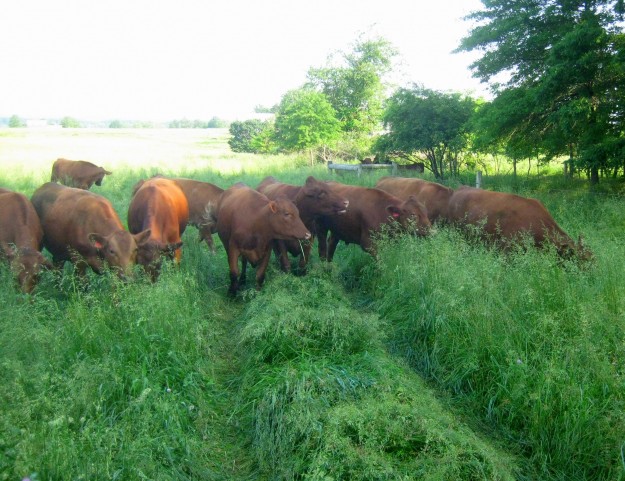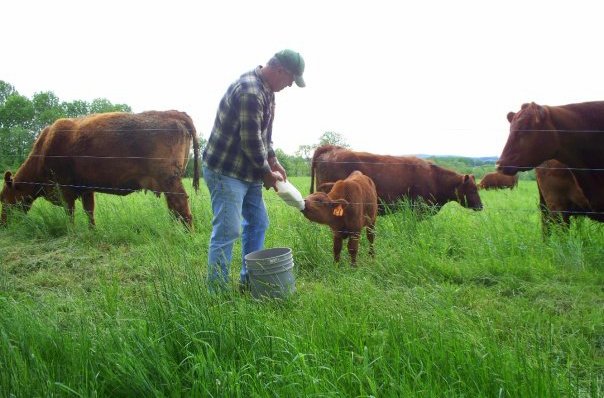16 Apr Tussock Sedge Farm’s Beef Share Program
Not only do we share a fence line and an equipment barn with Tussock Sedge Farm, but we also share with farm owners Henry and Charlotte Rosenberger similar farming ideals, and a passion for sustainable agriculture. We are happy to be able to share with our farm community this very local source of humanely raised, hormone and antibiotic-free grass fed beef. Below Henry Rosenberger tells the story of Tussock Sedge Farm.
What inspired you to get involved raising cows?
Henry Rosenberger: I grew up in the Rosenberger Dairy industry and I never enjoyed the early hours of milking cows and hauling milk. I did love the beef side of cows, where the calves are nourished drinking from “freshened” mother cows. Much of the land in Bucks County is especially “HEL”, “highly erodible land”, making grazing very suitable and more adaptable than row crop farming. Romantically speaking, it’s important to know, too, the Oklahoma! musical verses were written right here in Doylestown by Oscar Hammerstein … “all the cattle are standing like statues”.
How many cattle do you raise and on how much land?
HR: We raise about 100 calves from birth each year. Cows are mammals, taking nine months for gestation and usually only have one calf each year. We usually have two sets of twins each year. The calves are weaned after 8-10 months, giving the mother time to catch up on her nutritional diet before giving birth to her next calf. We graze and feed hay and minerals to the weaned calves for another 8-10 months for them to grow to maturity at 1150-1200 pounds. We graze up to 300 animals on 385 acres.
What’s the most challenging part of being a cow farmer?
HR: Making constant rounds to always be certain that every animal is safe and well cared for….. water, rotated fresh pastures, minerals and salt. Also, each year offers unique challenges: drought, too much rain, poor drying time for hay, and making adjustments to reconcile what you can’t change… such as the weather.
What’s the most rewarding?
HR: The most rewarding part of farming is watching and hearing nature heal the past use of herbicides and pesticides…. Hearing a choir of peepers and tree frogs in the evening… Seeing birthing calves drop and soon be standing aside the mother after being licked and encouraged to her/his feet for the first time….having experienced 90 births with no assistance…nature at it’s best. And finally, having patrons who appreciate all this and really genuinely share our enjoyment: “We love what you are doing” or “I can breathe better driving through this farm”.
Why did you make the decision to go with totally grass fed? What has that transition meant to your business?
HR: Why grass fed? Never were cows in their natural habitat eating corn. It was a place to “dump” cheap corn in the 60’s and 70’s (corn is no longer cheap). Grass fed beef offers higher Omega 3 fat and CLA and lower Omega 6 fat, which is unhealthy in excess. It is leaner than corn finished beef. A grass fed beef enjoys rotational grazing, which mimics a natural routine of always moving into fresh re-growth of grass and legumes, leaving behind waste and topped grass to recover.
The transition to grass fed beef meant we didn’t have meat to sell for a year because it takes two years, not 15 months, to finish beef on grass. It also meant we lost some customers who prefer corn fed fatty beef. We also gained many new customers who were convinced of the nutritional value of grass fed beef. Grass fed beef has a stronger bovine taste, a sweet and nutty flavor, when aged 5-10 days.
Is there anything special about the breed of cows you raise?
HR: The breed of cattle we choose is Red Angus cows bred by Rotakowa Devon bulls. The outcome of this cross is a highly productive converter of cellulose to protein. They represent a medium frame cow which performs well solely on grass and legumes.
How do you manage your pastures?
 HR: Management of pastures includes soil testing every three years. We maintain PH at 6.6-7.0 and mostly focus on cattle grazing to manage the pastures. They provide Nitrogen with their 20-30 lbs of manure and urea daily. The farmer manages the grass by moving cows into pastures at 12 inches until they eat it down to four inches. Special effort is made to dig bull thistles by hand but we never use herbicides on the pastures for weed control. But the best control of weeds is maintaining a high PH—weeds thrive in acidic soil. Having increased the organic matter from 1 ½ % to 4-7% is my most encouraging sign of optimum achievement in soil management.
HR: Management of pastures includes soil testing every three years. We maintain PH at 6.6-7.0 and mostly focus on cattle grazing to manage the pastures. They provide Nitrogen with their 20-30 lbs of manure and urea daily. The farmer manages the grass by moving cows into pastures at 12 inches until they eat it down to four inches. Special effort is made to dig bull thistles by hand but we never use herbicides on the pastures for weed control. But the best control of weeds is maintaining a high PH—weeds thrive in acidic soil. Having increased the organic matter from 1 ½ % to 4-7% is my most encouraging sign of optimum achievement in soil management.
What are your plans for the future of your farm—any changes in the works?
HR: Plans for the future involve adding sheep to our pastures. Currently we have seven ewes and births of five lambs in April 2013. They, too, will be grass fed and finished Dorset sheep. We expect to have 50 ewes within a few years. We also are planning on longer grazing when weather allows by stockpiling grass (hay) in the fields to be eaten in winter. Cows are healthiest outdoors and prefer it to lying in barns all winter.
Our customers understand why CSA’s are important in the context of vegetable farming. What does buying a “share” of a cow means, and why that is helpful to you as the farmer?
We love a vegetable CSA and realize we share the risk of the farmer by “paying ahead” for my vegetable share. The same is true for marketing beef. The greatest assurance I have as a beef farmer is to know that what I am spending two years to raise, grow and graze, I will have someone to buy and consume it when it’s ready to harvest and process. It is very helpful when we can sell a 1/8th share (2 per year, 46 lbs each) or a 12 lb. Sampler Pack share (3 per year) in advance. We offer a discount to encourage buyers to purchase shares. This year the discount is 2012 prices in 2013. This saves $5 on each of the three Sampler Packs and $20 on each of the 1/8th packs. Our 2013 prices for individual packs go into effect on May 1. We will accept share applications until May 30. Share holders have priority in what is available each year. For Blooming Glen Farm CSA members who purchase shares, we are happy to deliver the beef order to the CSA for pick-up when you are getting your veggies.
To find out more details about the Tussock Sedge Farm beef share program, and to take advantage of the 2012 pricing, head over to Tussock Sedge Farm’s website.
Interview by Blooming Glen Farm co-owner and farmer, Tricia Borneman.







Sorry, the comment form is closed at this time.